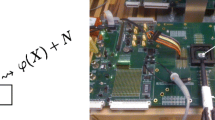Abstract
Using algebraic curves over finite fields, we construct some codes suitable for being used in the countermeasure called Direct Sum Masking which allows, when properly implemented, to protect the whole cryptographic block cipher algorithm against side channel attacks and fault injection attacks, simultaneously. These codes address a problem which has its own interest in coding theory.
Access this chapter
Tax calculation will be finalised at checkout
Purchases are for personal use only
Similar content being viewed by others
References
Bhasin, S., Danger, J.-L., Guilley, S., Najm, Z., Ngo, X.T.: Linear complementary dual code improvement to strengthen encoded circuit against hardware Trojan horses. In: IEEE International Symposium on Hardware Oriented Security and Trust (HOST), 5–7 May 2015
Bringer, J., Carlet, C., Chabanne, H., Guilley, S., Maghrebi, H.: Orthogonal direct sum masking. In: Naccache, D., Sauveron, D. (eds.) WISTP 2014. LNCS, vol. 8501, pp. 40–56. Springer, Heidelberg (2014). https://doi.org/10.1007/978-3-662-43826-8_4
Carlet, C., Daif, A., Guilley, S., Tavernier, C.: Polynomial direct sum masking to protect against both SCA and FIA. J. Cryptogr. Eng. (2018). https://doi.org/10.1007/s13389-018-0194-9
Carlet, C., Guilley, S.: Complementary dual codes for counter-measures to side-channel attacks. Adv. Math. Commun. 10(1), 131–150 (2016)
Carlet, C., Guilley, S.: Satatistical properties of side-channel and fault injection attacks using coding theory. Cryptogr. Commun. 10, 909–933 (2018)
Carlet, C., Güneri, C., Özbudak, F., Özkaya, B., Solé, P.: On linear complementary pairs of codes. IEEE Trans. Inf. Theory, to appear
Carlet, C., Güneri, C., Özbudak, F., Solé, P.: A new concatenated type construction for LCD codes and isometry codes. Discrete Math. 341, 830–835 (2018)
Carlet, C., Mesnager, S., Tang, C., Qi, Y.: Euclidean and Hermitian LCD MDS codes. Des. Codes Cryptogr. 86, 1–4 (2018). https://doi.org/10.1007/s10623-018-0463-8
Carlet, C., Mesnager, S., Tang, C., Qi, Y.: New characterization and parametrization of LCD codes. IEEE Trans. Inf. Theory, vol. To appear. https://arxiv.org/abs/1709.03217
Carlet, C., Mesnager, S., Tang, C., Qi, Y., Pellikaan, R.: Linear codes over \(\mathbb{F}_q\) are equivalent to LCD codes for \(q>3\). IEEE Trans. Inf. Theory 64(4), 3010–3017 (2018)
Ding, C., Li, C., Li, S.: LCD Cyclic codes over finite fields. arXiv:1608. 0217v1 [cs.IT]
Güneri, C., Özkaya, B., Solé, P.: Quasi-cyclic complementary dual codes. Finite Fields Appl. 42, 67–80 (2016)
Güneri, C., Özbudak, F., Özkaya, B., Saçıikara, E., Sepasdar, Z., Solé, P.: Structure and performance of generalized quasi-cyclic codes. Finite Fields Appl. 47, 183–202 (2017)
Li, S., Ding, C., Liu, H.: A family of reversible BCH codes. arXiv:1608.02169v1 [cs.IT]
Li, S., Ding, C., Liu, H.: Parameters of two classes of LCD BCH codes. arXiv:1608.02670 [cs.IT]
Mesnager, S., Tang, C., Qi, Y.: Complementary dual algebraic geometry codes. IEEE Trans. Inf. Theory 64(4), 2390–2397 (2018)
Jin, L.: Construction of MDS codes with complementary duals. IEEE Trans. Inf. Theory 63(5), 2843–2847 (2016)
SECODE Project Report: Preliminary assesment of the candidate codes with respect to fault injection attacks, December 2017
Stichtenoth, H.: Algebraic Function Fields and Codes. Springer, Heidelberg (1993)
Yang, X., Massey, J.L.: The condition for a cyclic code to have a complementary dual. J. Discrete Math. 126, 391–393 (1994)
Acknowledgement
Güneri and Özbudak are supported by the TÜBİTAK project 215E200, which is associated with the SECODE project in the scope of the CHIST-ERA Program. Carlet and Mesnager are also supported by the SECODE Project.
Author information
Authors and Affiliations
Corresponding author
Editor information
Editors and Affiliations
Rights and permissions
Copyright information
© 2018 Springer Nature Switzerland AG
About this paper
Cite this paper
Carlet, C., Güneri, C., Mesnager, S., Özbudak, F. (2018). Construction of Some Codes Suitable for Both Side Channel and Fault Injection Attacks. In: Budaghyan, L., Rodríguez-Henríquez, F. (eds) Arithmetic of Finite Fields. WAIFI 2018. Lecture Notes in Computer Science(), vol 11321. Springer, Cham. https://doi.org/10.1007/978-3-030-05153-2_5
Download citation
DOI: https://doi.org/10.1007/978-3-030-05153-2_5
Published:
Publisher Name: Springer, Cham
Print ISBN: 978-3-030-05152-5
Online ISBN: 978-3-030-05153-2
eBook Packages: Computer ScienceComputer Science (R0)




